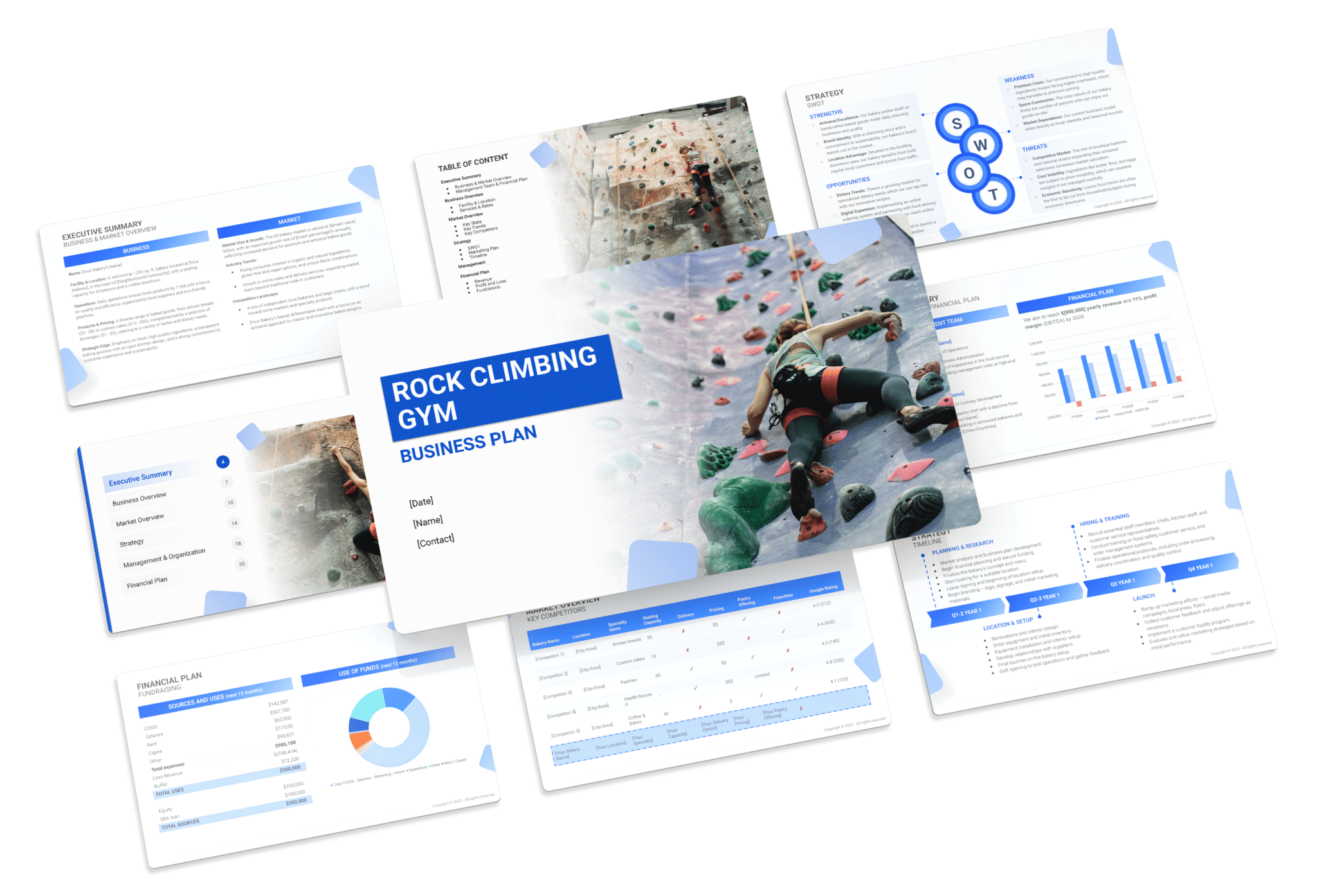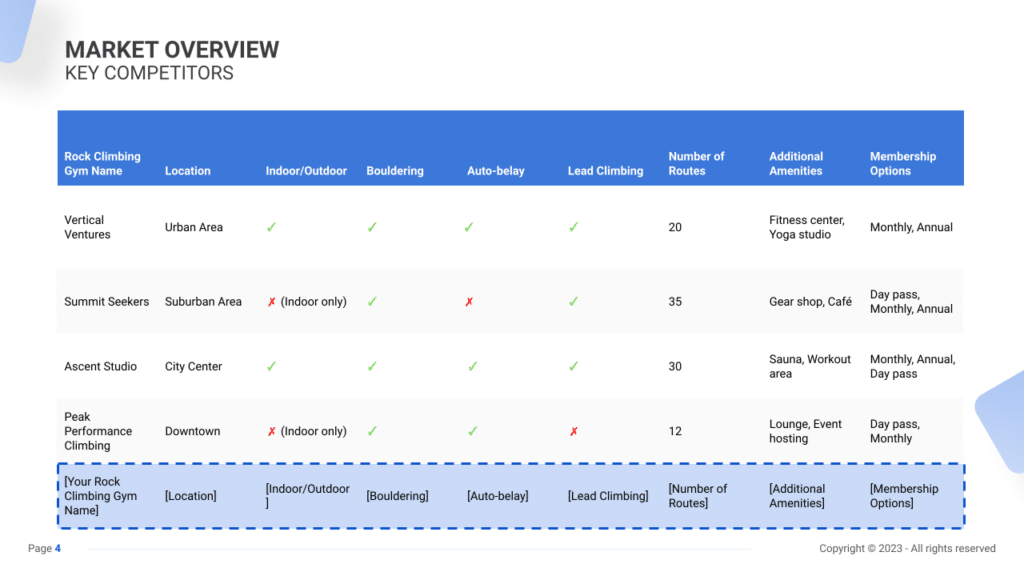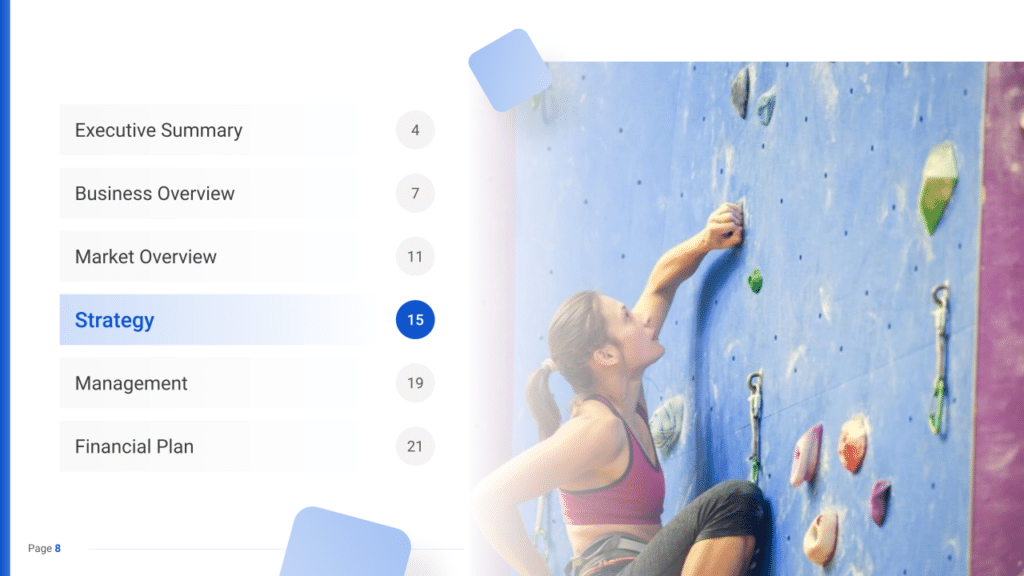Rock Climbing Gym Business Plan Template & PDF Example

Creating a comprehensive business plan is crucial for launching and running a successful rock climbing gym. This plan serves as your roadmap, detailing your vision, operational strategies, and financial plan. It helps establish your rock climbing gym’s identity, navigate the competitive market, and secure funding for growth.
This article not only breaks down the critical components of a rock climbing gym business plan, but also provides an example of a business plan to help you craft your own.
Whether you’re an experienced entrepreneur or new to the fitness industry, this guide, complete with a business plan example, lays the groundwork for turning your rock climbing gym business concept into reality. Let’s dive in!
The Plan
Our rock climbing gym business plan is structured to cover all essential aspects needed for a comprehensive strategy. It outlines the gym’s operations, marketing strategy, market environment, competitors, management team, and financial forecasts.
- Executive Summary: Offers an overview of your rock climbing gym’s business concept, market analysis, management, and financial strategy.
- Business Overview: Provides detailed information on what your rock climbing gym offers and its operational model:
- Facility & Location: Describes the gym’s design, amenities, and why its location is appealing to potential clients.
- Services & Rates: Lists the services provided by your rock climbing gym, including types of climbing walls, classes, memberships, and pricing structure.
- Market Overview: Examines the rock climbing gym industry landscape, identifying competitors and how your gym stands out:
- Key Stats: Shares industry size, growth trends, and relevant statistics for the rock climbing gym market.
- Key Trends: Highlights recent trends affecting the rock climbing and fitness sector.
- Key Competitors: Analyzes main competitors nearby and how your gym differs from them.
- Strategy: Outlines how the rock climbing gym intends to achieve growth and attract clients:
- SWOT: Strengths, weaknesses, opportunities, and threats analysis.
- Marketing Plan: Strategies for attracting and retaining customers.
- Timeline: Key milestones and objectives from start-up through the first year of operation.
- Management: Information on who manages the rock climbing gym and their roles.
- Financial Plan: Projects the gym’s 5-year financial performance, including revenue, profits, and expected expenses.

Executive Summary
The Executive Summary introduces your rock climbing gym’s business plan, offering a concise overview of your gym and its services. It should detail your market positioning, the range of climbing and fitness services you offer, its location, size, and an outline of day-to-day operations.
This section should also explore how your rock climbing gym will integrate into the local market, including the number of direct competitors within the area, identifying who they are, along with your gym’s unique selling points that differentiate it from these competitors.
Furthermore, you should include information about the management and co-founding team, detailing their roles and contributions to the gym’s success. Additionally, a summary of your financial projections, including revenue and profits over the next five years, should be presented here to provide a clear picture of your gym’s financial plan.
Rock Climbing Gym Business Plan Executive Summary Example
Business Overview
For a rock climbing gym, the Business Overview section can be concisely divided into 2 main slides:
Facility & Location
Briefly describe the gym’s physical environment, emphasizing its design, safety features, and the overall atmosphere that welcomes climbers. Mention the gym’s location, highlighting its accessibility and the convenience it offers to clients, such as proximity to public transportation, shopping centers, or ease of parking. Explain why this location is advantageous in attracting your target clientele.
Services & Rates
Detail the range of climbing services and amenities offered, from basic climbing sessions and equipment rentals to specialized classes like bouldering, lead climbing, or technique workshops. Outline your pricing strategy, ensuring it reflects the quality of services provided and matches the market you’re targeting. Highlight any packages, membership deals, or loyalty programs that provide added value to your clients, encouraging repeat business and customer loyalty.
Market Overview

Industry Size & Growth
In the Market Overview of your rock climbing gym business plan, start by examining the size of the rock climbing industry and its growth potential. This analysis is crucial for understanding the market’s scope and identifying expansion opportunities.
Key Market Trends
Proceed to discuss recent market trends, such as the increasing consumer interest in indoor climbing facilities, the growth of climbing as a mainstream sport, and the emphasis on fitness and wellness. For example, highlight the demand for varied climbing experiences, from bouldering to lead climbing, alongside the rising popularity of family-friendly and beginner-focused climbing gyms.
Competitive Landscape
A competitive analysis is not just a tool for gauging the position of your rock climbing gym in the market and its key competitors; it’s also a fundamental component of your business plan.
This analysis helps in identifying your rock climbing gym’s unique selling points, essential for differentiating your business in a competitive market.
In addition, the competitive analysis is integral in laying a solid foundation for your business plan. By examining various operational aspects of your competitors, you gain valuable information that ensures your business plan is robust, informed, and tailored to succeed in the current market environment.
Identifying Your Competitors in the Rock Climbing Industry
Identifying your competitors is the initial step in the competitive analysis process. Begin by cataloging other rock climbing gyms in your vicinity. For example, if your gym specializes in bouldering, your direct competitors include nearby gyms that focus on bouldering as well as larger fitness centers that offer rock climbing walls. It’s also important to consider indirect competitors like outdoor adventure clubs and online virtual climbing experiences.
Utilize online tools like Google Maps to gain a geographical perspective of competitor locations. Platforms such as Yelp and Google Reviews can provide customer reviews and ratings, offering insights into competitors’ strengths and weaknesses. For instance, if a nearby gym is frequently praised for its comprehensive climbing courses and expert instructors, this highlights a significant competitive advantage.

Rock Climbing Gym Competitors’ Strategies
Analyzing your competitors’ strategies involves several dimensions:
- Climbing Facilities: Examine the types and quality of climbing walls offered. If “Peak Climbers Gym” nearby is popular for its advanced climbing routes and variety of wall types, it indicates a benchmark you might need to meet.
- Training Programs: Look at the training programs and climbing classes offered. A gym like “Vertical Limits” that offers specialized training sessions for different skill levels might attract a broader range of climbers.
- Pricing Strategy: Compare your membership fees and pricing structure with those of your competitors. Are your prices more aligned with the economical “Community Climb Gym” or the high-end “Elite Climbers Lounge”?
- Marketing Tactics: Evaluate how competitors promote their facilities. Do they use social media effectively, sponsor local climbing events, or offer membership discounts during off-peak seasons?
- Additional Amenities: Consider other amenities provided such as gear shops, cafés, or workout areas. For example, “Adventure Base Gym” might be favored for its one-stop-shop approach that enhances the overall customer experience.
- Operational Efficiency: Note if competitors are utilizing technology or innovative processes to enhance customer convenience, such as online booking systems or automated check-in kiosks.
What’s Your Rock Climbing Gym’s Value Proposition?
Reflect on what makes your climbing gym unique. Perhaps your gym offers a family-friendly environment with climbing areas designed for children, or maybe it’s known for hosting prestigious climbing competitions.
Identify market opportunities through customer feedback and trends in the fitness and adventure sports industry. For example, the rising popularity of fitness integration in climbing gyms, offering yoga or functional fitness classes, could be a significant niche if competitors have not yet tapped into it.
Consider your location: A gym in a metropolitan area might focus on catering to busy professionals with flexible hours and quick climbing sessions, while a gym in a more rural area could capitalize on weekend family outings and extensive climbing courses.
Strategy

SWOT
First, conduct a SWOT analysis for the rock climbing gym, highlighting Strengths (such as expert instructors and a wide array of climbing routes and services), Weaknesses (including high operational costs and limited space for expansion), Opportunities (for example, the increasing trend in fitness and wellness activities), and Threats (such as economic downturns that may decrease consumer spending on recreational activities).

Marketing Plan
Next, develop a marketing strategy that outlines how to attract and retain clients through targeted advertising, promotional discounts, an engaging social media presence, and community involvement.
Marketing Channels
Utilize diverse marketing channels to effectively reach and engage with climbers.
Digital Marketing
- Leveraging Social Media Platforms: Utilize platforms like Instagram, Facebook, TikTok, and YouTube as dynamic tools to showcase your gym’s climbing routes, member achievements, training insights, and upcoming events. Engage climbers by sharing informative content, offering tips for beginners, and providing behind-the-scenes glimpses into the gym’s atmosphere.
- Building a Comprehensive Website: Design an intuitive website that serves as a comprehensive hub for potential and existing members. Showcase gym facilities, diverse membership plans, schedules, testimonials, and an engaging blog featuring climbing-related articles, tips, success stories, and updates. Implement strategies to enhance your website’s visibility in search engine results, ensuring that climbers searching for local climbing gyms find yours easily.
Local Advertising
- Distribute flyers strategically: Place well-designed flyers strategically in outdoor gear shops, universities, adventure clubs, and other locations frequented by climbing enthusiasts. Additionally, advertise in local magazines, and sports events, or consider sponsoring climbing competitions to augment brand visibility within the community.
- Engage with the Community: Organize and sponsor outdoor climbing workshops, and local climbing festivals, or host free introductory sessions aimed at connecting with the climbing community. These efforts not only generate interest but also solidify your gym’s presence in the local climbing scene.
Promotional Activities
- Launch Special Initiatives: Attract newcomers with ‘Climbing Crash Courses,’ ‘Open House Days,’ or ‘Free Trial Sessions’ to showcase your gym’s offerings and expertise.
- Encourage Referral Programs: Incentivize existing members to refer friends or family by offering enticing rewards such as discounts, extended memberships, or complimentary gear rentals for successful referrals, thus fostering a sense of community.

Sales Channels
Implement efficient sales channels to boost revenue and foster customer loyalty.
Membership Sales
- Tailored Membership Options: Develop flexible membership tiers that accommodate diverse climbing frequencies and preferences. Consider family packages, student discounts, or off-peak hour memberships to attract and cater to different customer segments.
- Value-added Benefits: Enhance the membership experience by offering early-bird discounts, exclusive access to certain routes, complimentary training sessions, or guest passes for members, thereby elevating overall member satisfaction.
In-Gym Sales and Services
- Pro Shop Opportunities: Equip a pro shop within the gym selling climbing gear, apparel, accessories, and nutritional supplements. Hire knowledgeable staff to assist climbers in making informed purchases.
- Specialized Training Programs: Introduce specialized training sessions led by experienced climbers, catering to different skill levels and interests. These programs can include technique workshops, strength training sessions, and route-setting clinics.
Online Booking and Sales
- Streamlined Booking Platforms: Implement an efficient and user-friendly online booking system allowing climbers to reserve slots for classes, guided climbs, or private sessions effortlessly.
- E-commerce Integration: Establish an e-commerce store on your website, offering merchandise, climbing equipment, online tutorials, and even memberships for sale.
Customer Loyalty Programs
- Rewarding Loyalty: Develop a robust rewards system where frequent climbers earn points or credits for each visit, redeemable for free sessions, discounts on merchandise, priority access to exclusive climbing events, or other enticing benefits.
- Engage through Member Events: Host a variety of member-exclusive events, workshops, or climbing competitions to foster a sense of belonging and camaraderie within your gym’s community, thereby enhancing member satisfaction and retention.
Strategy Timeline
Finally, create a detailed timeline that outlines critical milestones for the rock climbing gym’s opening, marketing efforts, client base growth, and expansion objectives, ensuring the business moves forward with clear direction and purpose.

Management
The Management section focuses on the rock climbing gym’s management and their direct roles in daily operations and strategic direction. This part is crucial for understanding who is responsible for making key decisions and driving the rock climbing gym toward its financial and operational goals.
For your rock climbing gym business plan, list the core team members, their specific responsibilities, and how their expertise supports the business.


Financial Plan
The Financial Plan section is a comprehensive analysis of your financial projections for revenue, expenses, and profitability. It lays out your rock climbing gym’s approach to securing funding, managing cash flow, and achieving breakeven.
This section typically includes detailed forecasts for the first 5 years of operation, highlighting expected revenue, operating costs and capital expenditures.
For your rock climbing gym business plan, provide a snapshot of your financial statement (profit and loss, balance sheet, cash flow statement), as well as your key assumptions (e.g. number of customers and prices, expenses, etc.).
Make sure to cover here
_ Profit and Loss
_ Cash Flow Statement
_ Balance Sheet
_ Use of Funds









